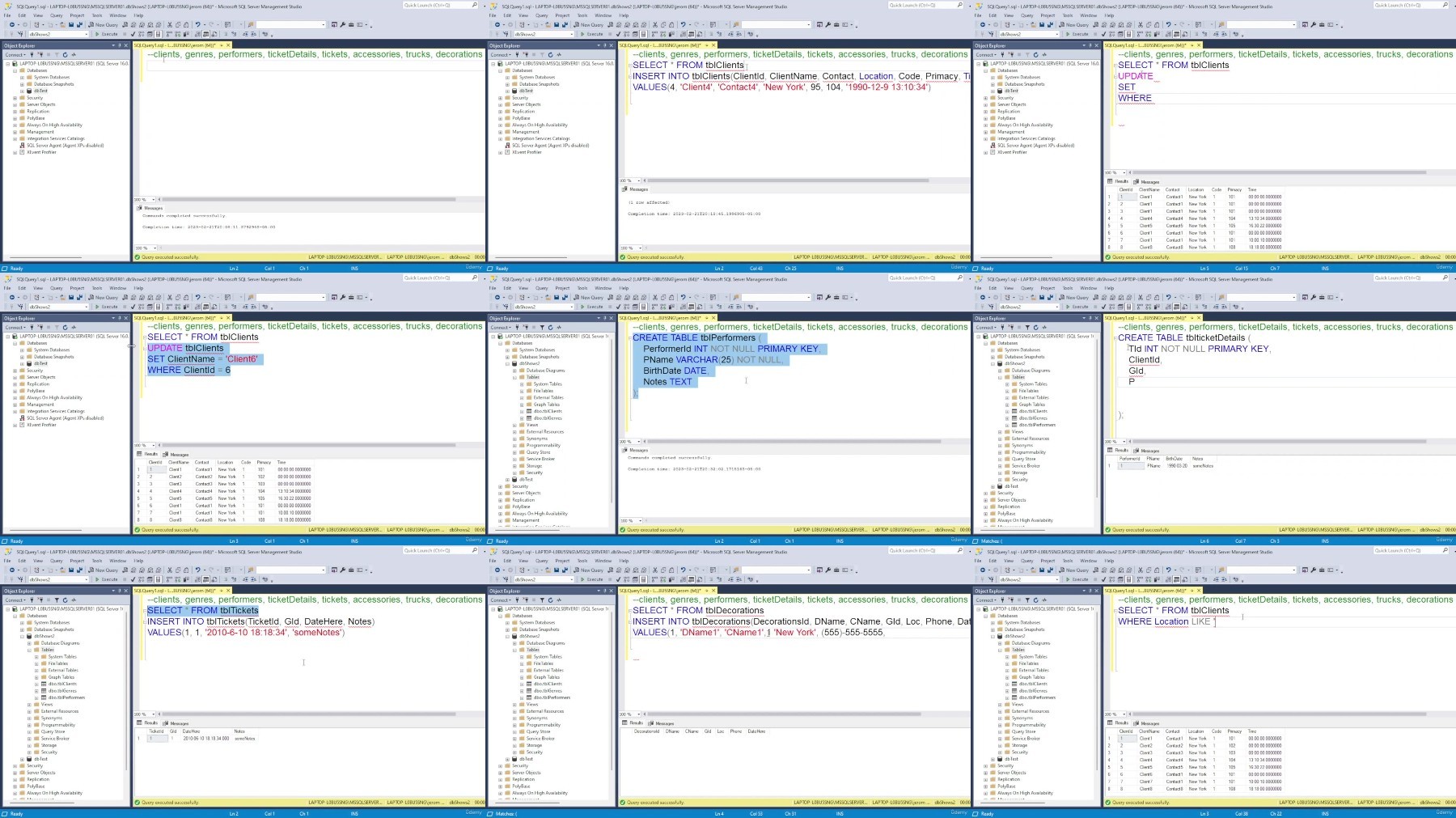Most Commented
Complete Sql Megacourse: Beginner To Expert




Description material

Complete Sql Megacourse: Beginner To Expert
Published 5/2023
MP4 | Video: h264, 1280x720 | Audio: AAC, 44.1 KHz
Language: English | Size: 30.26 GB | Duration: 55h 54m
Unlock the Full Potential of Data Management with the Ultimate SQL Mastery Course
What you'll learn
Understand the fundamental concepts of SQL
The different databases commonly used in SQL, and how to choose and work with the appropriate database for your project
Overview of the history of SQL and its architecture and understand what a RDBMS is and how it works
Explore the different attributes and concepts in SQL, including data types, operators, keys, NULL values, and data integrity
SQL commands and expressions, including creating tables, dropping tables, selecting data, inserting data, updating data, and more
Understand aggregate functions, the HAVING clause, and how to use them to summarize data
Explore string and date/time functions in SQL and how to use them to manipulate data
How to use advanced SQL features such as views, indexes, and windows functions
Requirements
No previous knowledge of SQL required
A desire to learn!
A positive attitude!
Description
Unleash the Power of SQL to Manage Data, Optimize Performance, and Streamline Your Workflow!Boost Your Efficiency and Productivity by Mastering SQL Skills!"Have you ever wanted to work in an IT related field? In the era of digital technology, we are all looking to enhance our careers and grow. Maybe you want to help a company manage their data, or fix the imperfections in the data they maintain. Whether you're an experienced IT professional or hoping to make a career out of it, we're here to show you the way.We are here to teach you SQL, the language of the database that allows you to operate databases and facilitate data effectively for a company.In this course, you'll learn everything about the fundamentals of using SQL to manage data in a Relational Database Management System. You're going to learn how to build objects like tables to expand your database, from adding records and fields to applying access restrictions, running queries and managing memory within your database. You'll even learn how to use specific clauses in your queries to return more complex result-sets.Our instructors have years of experience not only in Data Management and SQL, but also in teaching, and the expertly-crafted syllabus is designed to be easy to follow and thorough. We've even included plenty of interactive exercises and curated content for you to study. That's why this is the only SQL course you'll ever need to master the essential skills to manage and manipulate data, optimize database performance, and automate tasks.Start exploring the power of SQL today!After taking this course, you will be able to:Create and manage databases using SQL syntax and commands.Use different types of SQL operators, including arithmetic, comparison, and logical operators.Work with different SQL data types and understand their uses and limitations.Utilize SQL functions and expressions to extract and manipulate data.Write complex SQL queries using subqueries and joins to retrieve and analyze data from multiple tables.Implement data integrity constraints to ensure data consistency and accuracy.Optimize database performance using indexes and advanced SQL techniques.Understand and implement advanced SQL concepts such as schema structures and window functions.
Overview
Section 1: Overview
Lecture 1 Introduction
Lecture 2 What is SQL
Lecture 3 What is a RDBMS
Lecture 4 What is a Table
Lecture 5 Common Rules
Lecture 6 List of Databases
Section 2: SQL Attributes and Concepts
Lecture 7 Data Types
Lecture 8 Operators in Detail
Lecture 9 Records vs. Rows
Lecture 10 Fields vs. Columns
Lecture 11 Keys
Lecture 12 SQL Constraints
Lecture 13 SQL Structure Overview
Section 3: SQL Commands and Expressions
Lecture 14 Create New Database
Lecture 15 Create Tables
Lecture 16 Insert Data
Lecture 17 The SELECT Statement
Lecture 18 The WHERE Clause
Lecture 19 Conjunctive Operators
Section 4: More with SQL
Lecture 20 Updated Queries
Lecture 21 The LIKE Clause
Lecture 22 The TOP Clause
Lecture 23 More Keys
Lecture 24 Get Unique Records
Lecture 25 Sorted Order
Lecture 26 Normal Forms
Section 5: SQL Exercises Section I
Lecture 27 Exercises Introduction
Lecture 28 Exercise Area 1-1
Lecture 29 Exercise Area 1-2
Lecture 30 Exercise Area 1-3
Lecture 31 Exercise Area 1-4
Lecture 32 Exercise Area 1-5
Lecture 33 Exercise Area 1-6
Lecture 34 Exercise Area 1-7
Lecture 35 Exercise Area 1-8
Lecture 36 Exercise Area 1-9
Lecture 37 Exercise Area 1-10
Section 6: SQL Exercises Section II
Lecture 38 Exercises Area 2-1
Lecture 39 Exercises Area 2-2
Lecture 40 Exercises Area 2-3
Lecture 41 Exercises Area 2-4
Lecture 42 Exercises Area 2-5
Lecture 43 Exercises Area 2-6
Lecture 44 Exercises Area 2-7
Lecture 45 Exercises Area 2-8
Lecture 46 Exercises Area 2-9
Lecture 47 Exercises Area 2-10
Section 7: SQL Exercises Section III
Lecture 48 Exercises Area 3-1
Lecture 49 Exercises Area 3-2
Lecture 50 Exercises Area 3-3
Lecture 51 Exercises Area 3-4
Lecture 52 Exercises Area 3-5
Lecture 53 Exercises Area 3-6
Lecture 54 Exercises Area 3-7
Lecture 55 Exercises Area 3-8
Lecture 56 Exercises Area 3-9
Lecture 57 Exercises Area 3-10
Section 8: SQL Exercises Section IV
Lecture 58 Exercises Area 4-1
Lecture 59 Exercises Area 4-2
Lecture 60 Exercises Area 4-3
Lecture 61 Exercises Area 4-4
Lecture 62 Exercises Area 4-5
Lecture 63 Exercises Area 4-6
Lecture 64 Exercises Area 4-7
Lecture 65 Exercises Area 4-8
Lecture 66 Exercises Area 4-9
Lecture 67 Exercises Area 4-10
Section 9: SQL Exercises Section V
Lecture 68 Exercises Area 5-1
Lecture 69 Exercises Area 5-2
Lecture 70 Exercises Area 5-3
Lecture 71 Exercises Area 5-4
Lecture 72 Exercises Area 5-5
Lecture 73 Exercises Area 5-6
Lecture 74 Exercises Area 5-7
Lecture 75 Exercises Area 5-8
Lecture 76 Exercises Area 5-9
Lecture 77 Exercises Area 5-10
Section 10: SQL Beginner Outro
Lecture 78 Review
Lecture 79 Outro
Section 11: Introduction to SQL Advanced
Lecture 80 Introduction
Lecture 81 Course Focus
Lecture 82 Review SQL Objects
Lecture 83 Wildcard Operators
Lecture 84 Wildcard Operators Exercises Pt. 1
Lecture 85 Wildcard Operators Exercises Pt. 2
Section 12: SQL JOIN Syntax and Practice
Lecture 86 SQL JOINS Syntax
Lecture 87 SQL JOINS Exercises Pt. 1
Lecture 88 SQL JOINS Exercises Pt. 2
Section 13: Aggregate Functions
Lecture 89 Aggregate Functions
Lecture 90 The HAVING Clause
Lecture 91 Aggregate Functions Exercises
Section 14: String and DATE/TIME Functions
Lecture 92 String Functions Area I
Lecture 93 String Functions Area II
Lecture 94 String Functions Area III
Lecture 95 String Functions Area IV
Lecture 96 DATE/TIME Functions Area I
Lecture 97 DATE/TIME Functions Area II
Lecture 98 DATE/TIME Functions Area III
Lecture 99 DATE/TIME Functions Area IV
Section 15: Advanced JOINS
Lecture 100 Advanced JOINS Syntax
Lecture 101 Advanced JOINS Exercises Pt. 1
Lecture 102 Advanced JOINS Exercises Pt. 2
Section 16: SQL Programming
Lecture 103 SQL Programming Pt. 1
Lecture 104 SQL Programming Pt. 2
Lecture 105 Stored Procedures Pt. 1
Lecture 106 Stored Procedures Pt. 2
Section 17: Introduction to Tables
Lecture 107 Tables
Lecture 108 Demonstration Exercises
Section 18: Cursors and Transactions
Lecture 109 Cursors
Lecture 110 SQL Transactions Area I
Lecture 111 SQL Transactions Area II
Lecture 112 SQL Transactions Area III
Section 19: SQL Triggers
Lecture 113 SQL Triggers Area I
Lecture 114 SQL Triggers Area II
Lecture 115 SQL Triggers Area III
Section 20: View and Subqueries
Lecture 116 Views Area I
Lecture 117 Views Area II
Lecture 118 Subqueries Area I
Lecture 119 Subqueries Area II
Lecture 120 Advanced Subqueries Area I
Lecture 121 Advanced Subqueries Area II
Section 21: Indexes and Schema Structures
Lecture 122 Indexes Area I
Lecture 123 Indexes Area II
Lecture 124 Indexes Area III
Lecture 125 Indexes Area Demo
Lecture 126 Schema Structures Area I
Lecture 127 Schema Structures Area II
Section 22: Windows Functions
Lecture 128 Windows Functions Area I
Lecture 129 Windows Functions Area II
Lecture 130 Windows Functions Area III
Lecture 131 Windows Functions Area IV
Lecture 132 Windows Functions Area V
Lecture 133 Windows Functions Area VI
Section 23: Advanced SQL Programming
Lecture 134 SQL Programming Area I
Lecture 135 SQL Programming Area II
Lecture 136 SQL Programming Area III
Lecture 137 SQL Programming Area IV
Lecture 138 SQL Programming Area V
Lecture 139 SQL Programming Area VI
Section 24: SQL Advanced Exercises Section I
Lecture 140 Exercises Area 1-1
Lecture 141 Exercises Area 1-2
Lecture 142 Exercises Area 1-3
Lecture 143 Exercises Area 1-4
Lecture 144 Exercises Area 1-5
Lecture 145 Exercises Area 1-6
Lecture 146 Exercises Area 1-7
Lecture 147 Exercises Area 1-8
Lecture 148 Exercises Area 1-9
Lecture 149 Exercises Area 1-10
Lecture 150 Exercises Area 1-11
Lecture 151 Exercises Area 1-12
Section 25: SQL Advanced Exercises Section II
Lecture 152 Exercises Area 2-1
Lecture 153 Exercises Area 2-2
Lecture 154 Exercises Area 2-3
Lecture 155 Exercises Area 2-4
Lecture 156 Exercises Area 2-5
Lecture 157 Exercises Area 2-6
Lecture 158 Exercises Area 2-7
Lecture 159 Exercises Area 2-8
Lecture 160 Exercises Area 2-9
Lecture 161 Exercises Area 2-10
Lecture 162 Exercises Area 2-11
Lecture 163 Exercises Area 2-12
Section 26: SQL Advanced Outro
Lecture 164 Review
Lecture 165 Outro
Lecture 166 Last Words
Anyone who wants to learn SQL from scratch - no prior experience required!,Professionals who want to enhance their productivity and efficiency with data management and automation,Anyone who is currently working with data and wants to expand their knowledge of SQL to optimize database performance and streamline their workflow,Students who are interested in pursuing a career in data management, business intelligence, or data analytics

https://fikper.com/2GXJiarXkM/Udemy_Complete_SQL_Megacourse_Beginner_to_Expert.part01.rar.html
https://fikper.com/zVAcWw9Sqe/Udemy_Complete_SQL_Megacourse_Beginner_to_Expert.part02.rar.html
https://fikper.com/nqiZ5bkFb5/Udemy_Complete_SQL_Megacourse_Beginner_to_Expert.part03.rar.html
https://fikper.com/cTtLYowcoo/Udemy_Complete_SQL_Megacourse_Beginner_to_Expert.part04.rar.html
https://fikper.com/ZCJVvF7Nn8/Udemy_Complete_SQL_Megacourse_Beginner_to_Expert.part05.rar.html
https://fikper.com/d6tfGKoEfR/Udemy_Complete_SQL_Megacourse_Beginner_to_Expert.part06.rar.html
https://fikper.com/92WjJOZHlP/Udemy_Complete_SQL_Megacourse_Beginner_to_Expert.part07.rar.html
https://fikper.com/WDXVqvOOUj/Udemy_Complete_SQL_Megacourse_Beginner_to_Expert.part08.rar.html
https://fikper.com/6ggWbCE6ji/Udemy_Complete_SQL_Megacourse_Beginner_to_Expert.part09.rar.html
https://fikper.com/hFox0l45UF/Udemy_Complete_SQL_Megacourse_Beginner_to_Expert.part10.rar.html
https://fikper.com/md0zIJLyzV/Udemy_Complete_SQL_Megacourse_Beginner_to_Expert.part11.rar.html
https://fikper.com/4BLXN68dNX/Udemy_Complete_SQL_Megacourse_Beginner_to_Expert.part12.rar.html
https://fikper.com/uhjmzTxw1M/Udemy_Complete_SQL_Megacourse_Beginner_to_Expert.part13.rar.html
https://fikper.com/366X18jigV/Udemy_Complete_SQL_Megacourse_Beginner_to_Expert.part14.rar.html
https://fikper.com/BeyNpe6Blb/Udemy_Complete_SQL_Megacourse_Beginner_to_Expert.part15.rar.html
https://fikper.com/lHiGAobuPD/Udemy_Complete_SQL_Megacourse_Beginner_to_Expert.part16.rar.html
https://fikper.com/U1HfTpNcGG/Udemy_Complete_SQL_Megacourse_Beginner_to_Expert.part17.rar.html
https://fikper.com/eSqvrs7Qhs/Udemy_Complete_SQL_Megacourse_Beginner_to_Expert.part18.rar.html
https://fikper.com/KmSVwYbOqd/Udemy_Complete_SQL_Megacourse_Beginner_to_Expert.part19.rar.html
https://fikper.com/zv7tnk9d8q/Udemy_Complete_SQL_Megacourse_Beginner_to_Expert.part20.rar.html
https://fikper.com/eHtezn4URo/Udemy_Complete_SQL_Megacourse_Beginner_to_Expert.part21.rar.html
https://rapidgator.net/file/9b790d97b2d1cda21cdbfa8d7536f92c/Udemy_Complete_SQL_Megacourse_Beginner_to_Expert.part01.rar
https://rapidgator.net/file/e04c90e6bb693cde7021df04d350c662/Udemy_Complete_SQL_Megacourse_Beginner_to_Expert.part02.rar
https://rapidgator.net/file/b0e23e6966c527b41629cdc4ef4b6ced/Udemy_Complete_SQL_Megacourse_Beginner_to_Expert.part03.rar
https://rapidgator.net/file/f2c62199f51c39a137c9fd317605a642/Udemy_Complete_SQL_Megacourse_Beginner_to_Expert.part04.rar
https://rapidgator.net/file/e48c9e48142c6c4631c75850fcc132c0/Udemy_Complete_SQL_Megacourse_Beginner_to_Expert.part05.rar
https://rapidgator.net/file/2d094f3a0d8015aa9b48fc1c00beb90a/Udemy_Complete_SQL_Megacourse_Beginner_to_Expert.part06.rar
https://rapidgator.net/file/fa1b44175475afe5c5c0248a5d1b59b4/Udemy_Complete_SQL_Megacourse_Beginner_to_Expert.part07.rar
https://rapidgator.net/file/ba07e44576da5ddf4b018377b8e9f706/Udemy_Complete_SQL_Megacourse_Beginner_to_Expert.part08.rar
https://rapidgator.net/file/c712520e27aafd056f3ce5ab4e8a4499/Udemy_Complete_SQL_Megacourse_Beginner_to_Expert.part09.rar
https://rapidgator.net/file/a842348e87a52328159a4e92217bb067/Udemy_Complete_SQL_Megacourse_Beginner_to_Expert.part10.rar
https://rapidgator.net/file/5b7105517fe9e90cac471e57f006b7da/Udemy_Complete_SQL_Megacourse_Beginner_to_Expert.part11.rar
https://rapidgator.net/file/1533a28dc17facdc9999be988c82dafc/Udemy_Complete_SQL_Megacourse_Beginner_to_Expert.part12.rar
https://rapidgator.net/file/0f9992bdc6f0a05253f3b4ba80a3faa2/Udemy_Complete_SQL_Megacourse_Beginner_to_Expert.part13.rar
https://rapidgator.net/file/20a43c573ac6abd2d7e5902d17d9031a/Udemy_Complete_SQL_Megacourse_Beginner_to_Expert.part14.rar
https://rapidgator.net/file/b81f025c0017d6cc2ced0c90dc07f850/Udemy_Complete_SQL_Megacourse_Beginner_to_Expert.part15.rar
https://rapidgator.net/file/21a7683699b0c0829dbb6502aa8f1fcb/Udemy_Complete_SQL_Megacourse_Beginner_to_Expert.part16.rar
https://rapidgator.net/file/23852a0e8d6f6bd426c86a35d610e39d/Udemy_Complete_SQL_Megacourse_Beginner_to_Expert.part17.rar
https://rapidgator.net/file/7ccf196c9292718b3350f455ae2830a9/Udemy_Complete_SQL_Megacourse_Beginner_to_Expert.part18.rar
https://rapidgator.net/file/3a76ff68627b05267899368eaa016d36/Udemy_Complete_SQL_Megacourse_Beginner_to_Expert.part19.rar
https://rapidgator.net/file/ce4dd73ab9cc674fc889c7636d9c3092/Udemy_Complete_SQL_Megacourse_Beginner_to_Expert.part20.rar
https://rapidgator.net/file/040e8516042742233f3e469935bbcbf9/Udemy_Complete_SQL_Megacourse_Beginner_to_Expert.part21.rar

https://filestore.me/r0hmg41ng1ga/Udemy_Complete_SQL_Megacourse_Beginner_to_Expert.part01.rar
https://filestore.me/oxxkpaebax8o/Udemy_Complete_SQL_Megacourse_Beginner_to_Expert.part02.rar
https://filestore.me/u45iglmu8w6z/Udemy_Complete_SQL_Megacourse_Beginner_to_Expert.part03.rar
https://filestore.me/lhwr2ak4rvdg/Udemy_Complete_SQL_Megacourse_Beginner_to_Expert.part04.rar
https://filestore.me/wr74gconkagd/Udemy_Complete_SQL_Megacourse_Beginner_to_Expert.part05.rar
https://filestore.me/gxuuidtw1cc6/Udemy_Complete_SQL_Megacourse_Beginner_to_Expert.part06.rar
https://filestore.me/81nhwzqau8v4/Udemy_Complete_SQL_Megacourse_Beginner_to_Expert.part07.rar
https://filestore.me/wxz6zym9th3s/Udemy_Complete_SQL_Megacourse_Beginner_to_Expert.part08.rar
https://filestore.me/slp1m7vl6ppu/Udemy_Complete_SQL_Megacourse_Beginner_to_Expert.part09.rar
https://filestore.me/tm2ib7927t2t/Udemy_Complete_SQL_Megacourse_Beginner_to_Expert.part10.rar
https://filestore.me/5mbs4ceyztlr/Udemy_Complete_SQL_Megacourse_Beginner_to_Expert.part11.rar
https://filestore.me/epjaq7v41ixa/Udemy_Complete_SQL_Megacourse_Beginner_to_Expert.part12.rar
https://filestore.me/n1mp6aycht3s/Udemy_Complete_SQL_Megacourse_Beginner_to_Expert.part13.rar
https://filestore.me/j2rk8mq7o2a0/Udemy_Complete_SQL_Megacourse_Beginner_to_Expert.part14.rar
https://filestore.me/icwevr0agqbr/Udemy_Complete_SQL_Megacourse_Beginner_to_Expert.part15.rar
https://filestore.me/x1amfb3lc8h7/Udemy_Complete_SQL_Megacourse_Beginner_to_Expert.part16.rar
https://filestore.me/fllbqucst581/Udemy_Complete_SQL_Megacourse_Beginner_to_Expert.part17.rar
https://filestore.me/k4rieoobjb09/Udemy_Complete_SQL_Megacourse_Beginner_to_Expert.part18.rar
https://filestore.me/kd079puol0e2/Udemy_Complete_SQL_Megacourse_Beginner_to_Expert.part19.rar
https://filestore.me/wic8r8ux1kqn/Udemy_Complete_SQL_Megacourse_Beginner_to_Expert.part20.rar
https://filestore.me/qu53ua5m0inf/Udemy_Complete_SQL_Megacourse_Beginner_to_Expert.part21.rar
What you'll learn
Understand the fundamental concepts of SQL
The different databases commonly used in SQL, and how to choose and work with the appropriate database for your project
Overview of the history of SQL and its architecture and understand what a RDBMS is and how it works
Explore the different attributes and concepts in SQL, including data types, operators, keys, NULL values, and data integrity
SQL commands and expressions, including creating tables, dropping tables, selecting data, inserting data, updating data, and more
Understand aggregate functions, the HAVING clause, and how to use them to summarize data
Explore string and date/time functions in SQL and how to use them to manipulate data
How to use advanced SQL features such as views, indexes, and windows functions
Requirements
No previous knowledge of SQL required
A desire to learn!
A positive attitude!
Description
Unleash the Power of SQL to Manage Data, Optimize Performance, and Streamline Your Workflow!Boost Your Efficiency and Productivity by Mastering SQL Skills!"Have you ever wanted to work in an IT related field? In the era of digital technology, we are all looking to enhance our careers and grow. Maybe you want to help a company manage their data, or fix the imperfections in the data they maintain. Whether you're an experienced IT professional or hoping to make a career out of it, we're here to show you the way.We are here to teach you SQL, the language of the database that allows you to operate databases and facilitate data effectively for a company.In this course, you'll learn everything about the fundamentals of using SQL to manage data in a Relational Database Management System. You're going to learn how to build objects like tables to expand your database, from adding records and fields to applying access restrictions, running queries and managing memory within your database. You'll even learn how to use specific clauses in your queries to return more complex result-sets.Our instructors have years of experience not only in Data Management and SQL, but also in teaching, and the expertly-crafted syllabus is designed to be easy to follow and thorough. We've even included plenty of interactive exercises and curated content for you to study. That's why this is the only SQL course you'll ever need to master the essential skills to manage and manipulate data, optimize database performance, and automate tasks.Start exploring the power of SQL today!After taking this course, you will be able to:Create and manage databases using SQL syntax and commands.Use different types of SQL operators, including arithmetic, comparison, and logical operators.Work with different SQL data types and understand their uses and limitations.Utilize SQL functions and expressions to extract and manipulate data.Write complex SQL queries using subqueries and joins to retrieve and analyze data from multiple tables.Implement data integrity constraints to ensure data consistency and accuracy.Optimize database performance using indexes and advanced SQL techniques.Understand and implement advanced SQL concepts such as schema structures and window functions.
Overview
Section 1: Overview
Lecture 1 Introduction
Lecture 2 What is SQL
Lecture 3 What is a RDBMS
Lecture 4 What is a Table
Lecture 5 Common Rules
Lecture 6 List of Databases
Section 2: SQL Attributes and Concepts
Lecture 7 Data Types
Lecture 8 Operators in Detail
Lecture 9 Records vs. Rows
Lecture 10 Fields vs. Columns
Lecture 11 Keys
Lecture 12 SQL Constraints
Lecture 13 SQL Structure Overview
Section 3: SQL Commands and Expressions
Lecture 14 Create New Database
Lecture 15 Create Tables
Lecture 16 Insert Data
Lecture 17 The SELECT Statement
Lecture 18 The WHERE Clause
Lecture 19 Conjunctive Operators
Section 4: More with SQL
Lecture 20 Updated Queries
Lecture 21 The LIKE Clause
Lecture 22 The TOP Clause
Lecture 23 More Keys
Lecture 24 Get Unique Records
Lecture 25 Sorted Order
Lecture 26 Normal Forms
Section 5: SQL Exercises Section I
Lecture 27 Exercises Introduction
Lecture 28 Exercise Area 1-1
Lecture 29 Exercise Area 1-2
Lecture 30 Exercise Area 1-3
Lecture 31 Exercise Area 1-4
Lecture 32 Exercise Area 1-5
Lecture 33 Exercise Area 1-6
Lecture 34 Exercise Area 1-7
Lecture 35 Exercise Area 1-8
Lecture 36 Exercise Area 1-9
Lecture 37 Exercise Area 1-10
Section 6: SQL Exercises Section II
Lecture 38 Exercises Area 2-1
Lecture 39 Exercises Area 2-2
Lecture 40 Exercises Area 2-3
Lecture 41 Exercises Area 2-4
Lecture 42 Exercises Area 2-5
Lecture 43 Exercises Area 2-6
Lecture 44 Exercises Area 2-7
Lecture 45 Exercises Area 2-8
Lecture 46 Exercises Area 2-9
Lecture 47 Exercises Area 2-10
Section 7: SQL Exercises Section III
Lecture 48 Exercises Area 3-1
Lecture 49 Exercises Area 3-2
Lecture 50 Exercises Area 3-3
Lecture 51 Exercises Area 3-4
Lecture 52 Exercises Area 3-5
Lecture 53 Exercises Area 3-6
Lecture 54 Exercises Area 3-7
Lecture 55 Exercises Area 3-8
Lecture 56 Exercises Area 3-9
Lecture 57 Exercises Area 3-10
Section 8: SQL Exercises Section IV
Lecture 58 Exercises Area 4-1
Lecture 59 Exercises Area 4-2
Lecture 60 Exercises Area 4-3
Lecture 61 Exercises Area 4-4
Lecture 62 Exercises Area 4-5
Lecture 63 Exercises Area 4-6
Lecture 64 Exercises Area 4-7
Lecture 65 Exercises Area 4-8
Lecture 66 Exercises Area 4-9
Lecture 67 Exercises Area 4-10
Section 9: SQL Exercises Section V
Lecture 68 Exercises Area 5-1
Lecture 69 Exercises Area 5-2
Lecture 70 Exercises Area 5-3
Lecture 71 Exercises Area 5-4
Lecture 72 Exercises Area 5-5
Lecture 73 Exercises Area 5-6
Lecture 74 Exercises Area 5-7
Lecture 75 Exercises Area 5-8
Lecture 76 Exercises Area 5-9
Lecture 77 Exercises Area 5-10
Section 10: SQL Beginner Outro
Lecture 78 Review
Lecture 79 Outro
Section 11: Introduction to SQL Advanced
Lecture 80 Introduction
Lecture 81 Course Focus
Lecture 82 Review SQL Objects
Lecture 83 Wildcard Operators
Lecture 84 Wildcard Operators Exercises Pt. 1
Lecture 85 Wildcard Operators Exercises Pt. 2
Section 12: SQL JOIN Syntax and Practice
Lecture 86 SQL JOINS Syntax
Lecture 87 SQL JOINS Exercises Pt. 1
Lecture 88 SQL JOINS Exercises Pt. 2
Section 13: Aggregate Functions
Lecture 89 Aggregate Functions
Lecture 90 The HAVING Clause
Lecture 91 Aggregate Functions Exercises
Section 14: String and DATE/TIME Functions
Lecture 92 String Functions Area I
Lecture 93 String Functions Area II
Lecture 94 String Functions Area III
Lecture 95 String Functions Area IV
Lecture 96 DATE/TIME Functions Area I
Lecture 97 DATE/TIME Functions Area II
Lecture 98 DATE/TIME Functions Area III
Lecture 99 DATE/TIME Functions Area IV
Section 15: Advanced JOINS
Lecture 100 Advanced JOINS Syntax
Lecture 101 Advanced JOINS Exercises Pt. 1
Lecture 102 Advanced JOINS Exercises Pt. 2
Section 16: SQL Programming
Lecture 103 SQL Programming Pt. 1
Lecture 104 SQL Programming Pt. 2
Lecture 105 Stored Procedures Pt. 1
Lecture 106 Stored Procedures Pt. 2
Section 17: Introduction to Tables
Lecture 107 Tables
Lecture 108 Demonstration Exercises
Section 18: Cursors and Transactions
Lecture 109 Cursors
Lecture 110 SQL Transactions Area I
Lecture 111 SQL Transactions Area II
Lecture 112 SQL Transactions Area III
Section 19: SQL Triggers
Lecture 113 SQL Triggers Area I
Lecture 114 SQL Triggers Area II
Lecture 115 SQL Triggers Area III
Section 20: View and Subqueries
Lecture 116 Views Area I
Lecture 117 Views Area II
Lecture 118 Subqueries Area I
Lecture 119 Subqueries Area II
Lecture 120 Advanced Subqueries Area I
Lecture 121 Advanced Subqueries Area II
Section 21: Indexes and Schema Structures
Lecture 122 Indexes Area I
Lecture 123 Indexes Area II
Lecture 124 Indexes Area III
Lecture 125 Indexes Area Demo
Lecture 126 Schema Structures Area I
Lecture 127 Schema Structures Area II
Section 22: Windows Functions
Lecture 128 Windows Functions Area I
Lecture 129 Windows Functions Area II
Lecture 130 Windows Functions Area III
Lecture 131 Windows Functions Area IV
Lecture 132 Windows Functions Area V
Lecture 133 Windows Functions Area VI
Section 23: Advanced SQL Programming
Lecture 134 SQL Programming Area I
Lecture 135 SQL Programming Area II
Lecture 136 SQL Programming Area III
Lecture 137 SQL Programming Area IV
Lecture 138 SQL Programming Area V
Lecture 139 SQL Programming Area VI
Section 24: SQL Advanced Exercises Section I
Lecture 140 Exercises Area 1-1
Lecture 141 Exercises Area 1-2
Lecture 142 Exercises Area 1-3
Lecture 143 Exercises Area 1-4
Lecture 144 Exercises Area 1-5
Lecture 145 Exercises Area 1-6
Lecture 146 Exercises Area 1-7
Lecture 147 Exercises Area 1-8
Lecture 148 Exercises Area 1-9
Lecture 149 Exercises Area 1-10
Lecture 150 Exercises Area 1-11
Lecture 151 Exercises Area 1-12
Section 25: SQL Advanced Exercises Section II
Lecture 152 Exercises Area 2-1
Lecture 153 Exercises Area 2-2
Lecture 154 Exercises Area 2-3
Lecture 155 Exercises Area 2-4
Lecture 156 Exercises Area 2-5
Lecture 157 Exercises Area 2-6
Lecture 158 Exercises Area 2-7
Lecture 159 Exercises Area 2-8
Lecture 160 Exercises Area 2-9
Lecture 161 Exercises Area 2-10
Lecture 162 Exercises Area 2-11
Lecture 163 Exercises Area 2-12
Section 26: SQL Advanced Outro
Lecture 164 Review
Lecture 165 Outro
Lecture 166 Last Words
Anyone who wants to learn SQL from scratch - no prior experience required!,Professionals who want to enhance their productivity and efficiency with data management and automation,Anyone who is currently working with data and wants to expand their knowledge of SQL to optimize database performance and streamline their workflow,Students who are interested in pursuing a career in data management, business intelligence, or data analytics

https://fikper.com/2GXJiarXkM/Udemy_Complete_SQL_Megacourse_Beginner_to_Expert.part01.rar.html
https://fikper.com/zVAcWw9Sqe/Udemy_Complete_SQL_Megacourse_Beginner_to_Expert.part02.rar.html
https://fikper.com/nqiZ5bkFb5/Udemy_Complete_SQL_Megacourse_Beginner_to_Expert.part03.rar.html
https://fikper.com/cTtLYowcoo/Udemy_Complete_SQL_Megacourse_Beginner_to_Expert.part04.rar.html
https://fikper.com/ZCJVvF7Nn8/Udemy_Complete_SQL_Megacourse_Beginner_to_Expert.part05.rar.html
https://fikper.com/d6tfGKoEfR/Udemy_Complete_SQL_Megacourse_Beginner_to_Expert.part06.rar.html
https://fikper.com/92WjJOZHlP/Udemy_Complete_SQL_Megacourse_Beginner_to_Expert.part07.rar.html
https://fikper.com/WDXVqvOOUj/Udemy_Complete_SQL_Megacourse_Beginner_to_Expert.part08.rar.html
https://fikper.com/6ggWbCE6ji/Udemy_Complete_SQL_Megacourse_Beginner_to_Expert.part09.rar.html
https://fikper.com/hFox0l45UF/Udemy_Complete_SQL_Megacourse_Beginner_to_Expert.part10.rar.html
https://fikper.com/md0zIJLyzV/Udemy_Complete_SQL_Megacourse_Beginner_to_Expert.part11.rar.html
https://fikper.com/4BLXN68dNX/Udemy_Complete_SQL_Megacourse_Beginner_to_Expert.part12.rar.html
https://fikper.com/uhjmzTxw1M/Udemy_Complete_SQL_Megacourse_Beginner_to_Expert.part13.rar.html
https://fikper.com/366X18jigV/Udemy_Complete_SQL_Megacourse_Beginner_to_Expert.part14.rar.html
https://fikper.com/BeyNpe6Blb/Udemy_Complete_SQL_Megacourse_Beginner_to_Expert.part15.rar.html
https://fikper.com/lHiGAobuPD/Udemy_Complete_SQL_Megacourse_Beginner_to_Expert.part16.rar.html
https://fikper.com/U1HfTpNcGG/Udemy_Complete_SQL_Megacourse_Beginner_to_Expert.part17.rar.html
https://fikper.com/eSqvrs7Qhs/Udemy_Complete_SQL_Megacourse_Beginner_to_Expert.part18.rar.html
https://fikper.com/KmSVwYbOqd/Udemy_Complete_SQL_Megacourse_Beginner_to_Expert.part19.rar.html
https://fikper.com/zv7tnk9d8q/Udemy_Complete_SQL_Megacourse_Beginner_to_Expert.part20.rar.html
https://fikper.com/eHtezn4URo/Udemy_Complete_SQL_Megacourse_Beginner_to_Expert.part21.rar.html
https://rapidgator.net/file/9b790d97b2d1cda21cdbfa8d7536f92c/Udemy_Complete_SQL_Megacourse_Beginner_to_Expert.part01.rar
https://rapidgator.net/file/e04c90e6bb693cde7021df04d350c662/Udemy_Complete_SQL_Megacourse_Beginner_to_Expert.part02.rar
https://rapidgator.net/file/b0e23e6966c527b41629cdc4ef4b6ced/Udemy_Complete_SQL_Megacourse_Beginner_to_Expert.part03.rar
https://rapidgator.net/file/f2c62199f51c39a137c9fd317605a642/Udemy_Complete_SQL_Megacourse_Beginner_to_Expert.part04.rar
https://rapidgator.net/file/e48c9e48142c6c4631c75850fcc132c0/Udemy_Complete_SQL_Megacourse_Beginner_to_Expert.part05.rar
https://rapidgator.net/file/2d094f3a0d8015aa9b48fc1c00beb90a/Udemy_Complete_SQL_Megacourse_Beginner_to_Expert.part06.rar
https://rapidgator.net/file/fa1b44175475afe5c5c0248a5d1b59b4/Udemy_Complete_SQL_Megacourse_Beginner_to_Expert.part07.rar
https://rapidgator.net/file/ba07e44576da5ddf4b018377b8e9f706/Udemy_Complete_SQL_Megacourse_Beginner_to_Expert.part08.rar
https://rapidgator.net/file/c712520e27aafd056f3ce5ab4e8a4499/Udemy_Complete_SQL_Megacourse_Beginner_to_Expert.part09.rar
https://rapidgator.net/file/a842348e87a52328159a4e92217bb067/Udemy_Complete_SQL_Megacourse_Beginner_to_Expert.part10.rar
https://rapidgator.net/file/5b7105517fe9e90cac471e57f006b7da/Udemy_Complete_SQL_Megacourse_Beginner_to_Expert.part11.rar
https://rapidgator.net/file/1533a28dc17facdc9999be988c82dafc/Udemy_Complete_SQL_Megacourse_Beginner_to_Expert.part12.rar
https://rapidgator.net/file/0f9992bdc6f0a05253f3b4ba80a3faa2/Udemy_Complete_SQL_Megacourse_Beginner_to_Expert.part13.rar
https://rapidgator.net/file/20a43c573ac6abd2d7e5902d17d9031a/Udemy_Complete_SQL_Megacourse_Beginner_to_Expert.part14.rar
https://rapidgator.net/file/b81f025c0017d6cc2ced0c90dc07f850/Udemy_Complete_SQL_Megacourse_Beginner_to_Expert.part15.rar
https://rapidgator.net/file/21a7683699b0c0829dbb6502aa8f1fcb/Udemy_Complete_SQL_Megacourse_Beginner_to_Expert.part16.rar
https://rapidgator.net/file/23852a0e8d6f6bd426c86a35d610e39d/Udemy_Complete_SQL_Megacourse_Beginner_to_Expert.part17.rar
https://rapidgator.net/file/7ccf196c9292718b3350f455ae2830a9/Udemy_Complete_SQL_Megacourse_Beginner_to_Expert.part18.rar
https://rapidgator.net/file/3a76ff68627b05267899368eaa016d36/Udemy_Complete_SQL_Megacourse_Beginner_to_Expert.part19.rar
https://rapidgator.net/file/ce4dd73ab9cc674fc889c7636d9c3092/Udemy_Complete_SQL_Megacourse_Beginner_to_Expert.part20.rar
https://rapidgator.net/file/040e8516042742233f3e469935bbcbf9/Udemy_Complete_SQL_Megacourse_Beginner_to_Expert.part21.rar

https://filestore.me/r0hmg41ng1ga/Udemy_Complete_SQL_Megacourse_Beginner_to_Expert.part01.rar
https://filestore.me/oxxkpaebax8o/Udemy_Complete_SQL_Megacourse_Beginner_to_Expert.part02.rar
https://filestore.me/u45iglmu8w6z/Udemy_Complete_SQL_Megacourse_Beginner_to_Expert.part03.rar
https://filestore.me/lhwr2ak4rvdg/Udemy_Complete_SQL_Megacourse_Beginner_to_Expert.part04.rar
https://filestore.me/wr74gconkagd/Udemy_Complete_SQL_Megacourse_Beginner_to_Expert.part05.rar
https://filestore.me/gxuuidtw1cc6/Udemy_Complete_SQL_Megacourse_Beginner_to_Expert.part06.rar
https://filestore.me/81nhwzqau8v4/Udemy_Complete_SQL_Megacourse_Beginner_to_Expert.part07.rar
https://filestore.me/wxz6zym9th3s/Udemy_Complete_SQL_Megacourse_Beginner_to_Expert.part08.rar
https://filestore.me/slp1m7vl6ppu/Udemy_Complete_SQL_Megacourse_Beginner_to_Expert.part09.rar
https://filestore.me/tm2ib7927t2t/Udemy_Complete_SQL_Megacourse_Beginner_to_Expert.part10.rar
https://filestore.me/5mbs4ceyztlr/Udemy_Complete_SQL_Megacourse_Beginner_to_Expert.part11.rar
https://filestore.me/epjaq7v41ixa/Udemy_Complete_SQL_Megacourse_Beginner_to_Expert.part12.rar
https://filestore.me/n1mp6aycht3s/Udemy_Complete_SQL_Megacourse_Beginner_to_Expert.part13.rar
https://filestore.me/j2rk8mq7o2a0/Udemy_Complete_SQL_Megacourse_Beginner_to_Expert.part14.rar
https://filestore.me/icwevr0agqbr/Udemy_Complete_SQL_Megacourse_Beginner_to_Expert.part15.rar
https://filestore.me/x1amfb3lc8h7/Udemy_Complete_SQL_Megacourse_Beginner_to_Expert.part16.rar
https://filestore.me/fllbqucst581/Udemy_Complete_SQL_Megacourse_Beginner_to_Expert.part17.rar
https://filestore.me/k4rieoobjb09/Udemy_Complete_SQL_Megacourse_Beginner_to_Expert.part18.rar
https://filestore.me/kd079puol0e2/Udemy_Complete_SQL_Megacourse_Beginner_to_Expert.part19.rar
https://filestore.me/wic8r8ux1kqn/Udemy_Complete_SQL_Megacourse_Beginner_to_Expert.part20.rar
https://filestore.me/qu53ua5m0inf/Udemy_Complete_SQL_Megacourse_Beginner_to_Expert.part21.rar
Join to our telegram Group
Information
Users of Guests are not allowed to comment this publication.
Users of Guests are not allowed to comment this publication.
Choose Site Language
Recommended news
Commented



![eM Client Pro 9.2.1735 Multilingual [Updated]](https://pikky.net/medium/wXgc.png)






![Movavi Video Editor 24.0.2.0 Multilingual [ Updated]](https://pikky.net/medium/qhrc.png)

